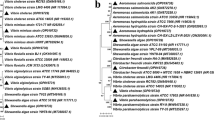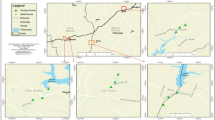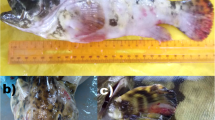Abstract
This study evaluated the potential pathogenicity and antimicrobial resistance (AMR) of Vibrio species isolated from inland saline shrimp culture farms. Out of 200 Vibrio isolates obtained from 166 shrimp/water samples, 105 isolates were identified as V. parahaemolyticus and 31 isolates were identified as V. alginolyticus and V. cholerae, respectively. During PCR screening of virulence-associated genes, the presence of the tlh gene was confirmed in 70 and 19 isolates of V. parahaemolyticus and V. alginolyticus, respectively. Besides, 10 isolates of V. parahaemolyticus were also found positive for trh gene. During antibiotic susceptibility testing (AST), very high resistance to cefotaxime (93.0%), amoxiclav (90.3%), ampicillin (88.2%), and ceftazidime (73.7%) was observed in all Vibrio species. Multiple antibiotic resistance (MAR) index values of Vibrio isolates ranged from 0.00 to 0.75, with 90.1% of isolates showing resistance to ≥ 3 antibiotics. The AST and MAR patterns did not significantly vary sample-wise or Vibrio species-wise. During the minimum inhibitory concentration (MIC) testing of various antibiotics against Vibrio isolates, the highest MIC values were recorded for amoxiclav followed by kanamycin. These results indicated that multi-drug resistant Vibrio species could act as the reservoirs of antibiotic resistance genes in the shrimp culture environment. The limited host range of 12 previously isolated V. parahaemolyticus phages against V. parahaemolyticus isolates from this study indicated that multiple strains of V. parahaemolyticus were prevalent in inland saline shrimp culture farms. The findings of the current study emphasize that routine monitoring of emerging aquaculture areas is critical for AMR pathogen risk assessment.



Similar content being viewed by others
Data availability
The study data is available from the corresponding author upon reasonable request.
References
Abdel-Latif HMR, Yilmaz E, Dawood MAO, Ringø E, Ahmadifar E, Yilmaz S (2022) Shrimp vibriosis and possible control measures using probiotics, postbiotics, prebiotics, and synbiotics: a review. Aquac 551:737951. https://doi.org/10.1016/j.aquaculture.2022.737951
Abdel-Tawwab M, Khalil RH, Nour AM, Elkhayat BK, Khalifa E, Abdel-Latif HMR (2022) Effects of Bacillus subtilis-fermented rice bran on water quality, performance, antioxidants/oxidants, and immunity biomarkers of White leg shrimp (Litopenaeus vannamei) reared at different salinities with zero water exchange. J Appl Aquacult 34:332–357. https://doi.org/10.1080/10454438.2020.1844110
Brenner DJ, Krieg NR, Staley JT (2005) Bergey`s manual of systematic bacteriology. Springer, USA
Cabello FC (2006) Heavy use of prophylactic antibiotics in aquaculture: a growing problem for human and animal health and for the environment. Environ Microbiol 8:1137–1144. https://doi.org/10.1111/j.1462-2920.2006.01054.x
Ceccarelli D, Alam M, Huq A, Colwell RR (2016) Reduced susceptibility to extended-spectrum β-lactams in Vibrio cholerae isolated in Bangladesh. Front Public Health 4:231. https://doi.org/10.3389/fpubh.2016.00231
Chandrakala N, Priya S, Ganesh PS (2014) Antibiotic sensitivity and MIC of Vibrio species isolated from diseased Penaeus monodon (Fab). Indian J Appl Microbiol 17:47–54
Chomvarin C, Jumroenjit W, Tangkanakul W, Hasan NA, Chaicumpar K, Faksri K, Huq A (2014) Genotype and drug resistance of clinical and environmental Vibrio cholerae non-o1/non-o139 in northeastern Thailand. Southeast Asian J Trop Med Public Health 45:1354–1364
CLSI (2016) Methods for antimicrobial dilution and disk susceptibility of infrequently isolated or fastidious bacteria, Clinical and Laboratory Standards Institute, Wayne, Pennsylvania
Dangtip S, Sirikharin R, Sanguanrut P, Thitamadee S, Sritunyalucksana K, Taengchaiyaphum S, Mavichak R, Proespraiwong P, Flegel TW (2015) AP4 method for two-tube nested PCR detection of AHPND isolates of Vibrio parahaemolyticus. Aquac Rep 2:158–162. https://doi.org/10.1016/j.aqrep.2015.10.002
Deng Y, Xu L, Chen H, Liu S, Guo Z, Cheng C, Ma H, Feng J (2020) Prevalence, virulence genes, and antimicrobial resistance of Vibrio species isolated from diseased marine fish in South China. Sci Rep 10:14329. https://doi.org/10.1038/s41598-020-71288-0
Dubey S, Singh A, Kumar BTN, Singh NK, Tyagi A (2021) Isolation and characterization of bacteriophages from inland saline aquaculture environments to control Vibrio parahaemolyticus contamination in shrimp. Indian J Microbiol 61:212–217. https://doi.org/10.1007/s12088-021-00934-6
El-Son MAM, Nofal MI, Abdel-Latif HMR (2021) Co-infection of Aeromonas hydrophila and Vibrio parahaemolyticus isolated from diseased farmed striped mullet (Mugil cephalus) in Manzala, Egypt – a case report. Aquaculture 530:735738. https://doi.org/10.1016/j.aquaculture.2020.735738
Elmahdi S, DaSilva LV, Parveen S (2016) Antibiotic resistance of Vibrio parahaemolyticus and Vibrio vulnificus in various countries: a review. Food Microbiol 57:128–134. https://doi.org/10.1016/j.fm.2016.02.008
FAO (2022) The state of world fisheries and aquaculture 2022. Towards Blue Transformation. FAO Rome
Ferrari RG, Panzenhagen PHN, Conte-Junior CA (2017) Phenotypic and genotypic eligible methods for Salmonella Typhimurium source tracking. Front Microbiol 8:2587. https://doi.org/10.3389/fmicb.2017.02587
Ghenem L, Elhadi N, Alzahrani F, Nishibuchi M (2017) Vibrio parahaemolyticus: a review on distribution, pathogenesis, virulence determinants and epidemiology. Saudi J Med Med Sci 5:93–103. https://doi.org/10.4103/sjmms.sjmms_30_17
Gopal S, Otta SK, Kumar S, Karunasagar I, Nishibuchi M, Karunasagar I (2005) The occurrence of Vibrio species in tropical shrimp culture environments; implications for food safety. Int J Food Microbiol 102:151–159. https://doi.org/10.1016/j.ijfoodmicro.2004.12.011
Haq IU, Chaudhry WN, Akhtar MN, Andleeb S, Qadri I (2012) Bacteriophages and their implications on future biotechnology: a review. Virol J 9:9. https://doi.org/10.1186/1743-422X-9-9
Hossain MS, Aktaruzzaman M, Fakhruddin ANM, Uddin MJ, Rahman SH, Chowdhury MAZ, Alam MK (2012) Antimicrobial susceptibility of Vibrio species isolated from brackish water shrimp culture environment. J Bangladesh Acad Sci 36:213–220. https://doi.org/10.3329/jbas.v36i2.12964
Ibrahim M, Ahmad F, Yaqub B, Ramzan A, Imran A, Afzaal M, Mirza SA, Mazhar I, Younus M, Akram Q, Ali Taseer MS, Ahmad A, Ahmed S (2020) Chapter 4 - Current trends of antimicrobials used in food animals and aquaculture. In: (ed Hashmi MZ (ed) Antibiotics and Antimicrobial Resistance Genes in the Environment, Elsevier, pp. 39–69
Igbinosa EO (2016) Detection and antimicrobial resistance of Vibrio isolates in aquaculture environments: implications for public health. Microb Drug Resist 22:238–245. https://doi.org/10.1089/mdr.2015.0169
Kang C-H, Shin Y, Yu H, Kim S, So J-S (2018) Antibiotic and heavy-metal resistance of Vibrio parahaemolyticus isolated from oysters in Korea. Mar Pollut Bull 135:69–74. https://doi.org/10.1016/j.marpolbul.2018.07.007
Kim HJ, Ryu JO, Lee SY, Kim ES, Kim HY (2015) Multiplex PCR for detection of the Vibrio genus and five pathogenic Vibrio species with primer sets designed using comparative genomics. BMC Microbiol 15:239. https://doi.org/10.1186/s12866-015-0577-3
Krumperman PH (1983) Multiple antibiotic resistance indexing of Escherichia coli to identify high-risk sources of fecal contamination of foods. Appl Environ Microbiol 46:165–170. https://doi.org/10.1128/aem.46.1.165-170.1983
Letchumanan V, Chan KG, Lee LH (2014) Vibrio parahaemolyticus: a review on the pathogenesis, prevalence, and advance molecular identification techniques. Front Microbiol 5:705. https://doi.org/10.3389/fmicb.2014.00705
Letchumanan V, Yin WF, Lee LH, Chan KG (2015) Prevalence and antimicrobial susceptibility of Vibrio parahaemolyticus isolated from retail shrimps in Malaysia. Front Microbiol 6:33. https://doi.org/10.3389/fmicb.2015.00033
Liu M, Wong MH, Chen S (2013) Molecular characterisation of a multidrug resistance conjugative plasmid from Vibrio parahaemolyticus. Int J Antimicrob Agents 42:575–579. https://doi.org/10.1016/j.ijantimicag.2013.08.014
Mahoney JC, Gerding MJ, Jones SH, Whistler CA (2010) Comparison of the pathogenic potentials of environmental and clinical Vibrio parahaemolyticus strains indicates a role for temperature regulation in virulence. Appl Environ Microbiol 76:7459–7465. https://doi.org/10.1128/AEM.01450-10
Obaidat MM, Salman AEB, Roess AA (2017) Virulence and antibiotic resistance of Vibrio parahaemolyticus isolates from seafood from three developing countries and of worldwide environmental, seafood, and clinical isolates from 2000 to 2017. J Food Prot 80:2060–2067. https://doi.org/10.4315/0362-028x.jfp-17-156
Parmar KM, Hathi ZJ, Dafale NA (2017) Control of multidrug-resistant gene flow in the environment through bacteriophage intervention. Appl Biochem Biotechnol 181:1007–1029. https://doi.org/10.1007/s12010-016-2265-7
Preena PG, Swaminathan TR, Kumar VJR, Singh ISB (2020) Antimicrobial resistance in aquaculture: a crisis for concern. Biologia 75:1497–1517. https://doi.org/10.2478/s11756-020-00456-4
Rai S, Tyagi A, Kalia A, Kumar BTN, Garg P, Singh NK (2020) Characterization and genome sequencing of three Aeromonas hydrophila-specific phages, CF8, PS1, and PS2. Arch Virol 165:1675–1678. https://doi.org/10.1007/s00705-020-04644-0
Rai S, Tyagi A, Naveen Kumar BT, Kaur S, Singh NK (2019) Isolation, genomic characterization and stability study of narrow-host range Aeromonas hydrophila lytic bacteriophage. J Exp Zool India 22:1075–1082
Saito S, Iwade Y, Tokuoka E, Nishio T, Otomo Y, Araki E, Konuma H, Nakagawa H, Tanaka H, Sugiyama K, Hasegawa A, Sugita-Konishi Y, Hara-Kudo Y (2015) Epidemiological evidence of lesser role of thermostable direct hemolysin (TDH)-related hemolysin (TRH) than TDH on Vibrio parahaemolyticus pathogenicity. Foodborne Pathog Dis 12:131–138. https://doi.org/10.1089/fpd.2014.1810
Singh B, Tyagi A, Billekallu Thammegowda NK, Ansal MD (2018) Prevalence and antimicrobial resistance of vibrios of human health significance in inland saline aquaculture areas. Aquacult Res 49:2166–2174. https://doi.org/10.1111/are.13672
Singh P, Ansal MD (2021) Shrimp farming in Punjab and the future. In: Aquapost (ed Pradhan P). http://www.aquapost.in/shrimp-farming-in-punjab-and-the-future/
Sudha S, Mridula C, Silvester R, Hatha AAM (2014) Prevalence and antibiotic resistance of pathogenic Vibrios in shellfishes from Cochin market. Indian J Geo-Mar Sci 43:815–824
Tada J, Ohashi T, Nishimura N, Shirasaki Y, Ozaki H, Fukushima S, Takano J, Nishibuchi M, Takeda Y (1992) Detection of the thermostable direct hemolysin gene (tdh) and the thermostable direct hemolysin-related hemolysin gene (trh) of Vibrio parahaemolyticus by polymerase chain reaction. Mol Cell Probes 6:477–487. https://doi.org/10.1016/0890-8508(92)90044-X
Takemura AF, Chien DM, Polz MF (2014) Associations and dynamics of Vibrionaceae in the environment, from the genus to the population level. Front Microbiol 5:38. https://doi.org/10.3389/fmicb.2014.00038
Tran L, Nunan L, Redman RM, Mohney LL, Pantoja CR, Fitzsimmons K, Lightner DV (2013) Determination of the infectious nature of the agent of acute hepatopancreatic necrosis syndrome affecting penaeid shrimp. Dis Aquat Org 105:45–55. https://doi.org/10.3354/dao02621
Tyagi A, Saravanan V, Karunasagar I, Karunasagar I (2009) Detection of Vibrio parahaemolyticus in tropical shellfish by SYBR green real-time PCR and evaluation of three enrichment media. Int J Food Microbiol 129:124–130. https://doi.org/10.1016/j.ijfoodmicro.2008.11.006
Yano Y, Hamano K, Satomi M, Tsutsui I, Ban M, Aue-umneoy D (2014) Prevalence and antimicrobial susceptibility of Vibrio species related to food safety isolated from shrimp cultured at inland ponds in Thailand. Food Control 38:30–36. https://doi.org/10.1016/j.foodcont.2013.09.019
Acknowledgements
The authors are grateful to the Dean (College of Fisheries, Guru Angad Dev Veterinary & Animal Sciences University, Ludhiana, India) for all the necessary support during this study.
Funding
Funding support from the Indian Council of Agricultural Research (ICAR) under the Niche Area of Excellence on “Antibiotic Resistance: Animal Human Interface” (Edn.10(8)/2016-EP&HS) to A. K. Arora was used to conduct this work.
Author information
Authors and Affiliations
Contributions
Prapti Sudan: methodology, investigation, data curation, visualization, and writing—original draft. Anuj Tyagi: conceptualization, methodology, investigation, writing—original draft, supervision, project administration, and funding acquisition. Rouf Ahmad Dar: methodology, investigation, data curation, and writing—review and editing. Chetna Sharma: investigation, data curation, writing—review and editing, and visualization. Prabjeet Singh: investigation, resources, data analysis, and writing—review and editing. Naveen Kumar B. T.: investigation, resources, and writing—review and editing. Mudit Chandra: methodology, resources, data curation, and writing—review and editing. A. K. Arora: conceptualization, writing—review & editing, project administration, and funding acquisition. All authors read and approved the final manuscript.
Corresponding author
Ethics declarations
Ethics approval
The study was conducted as per approved guidelines of the Committee for the Purpose of Control and Supervision of Experiments on Animals (CPCSEA), Government of India. The approval number for this study was PGS/A-1/20/2205–06 dated 07/08/2020.
Consent to participate
Not applicable.
Consent for publication
Not applicable.
Competing interests
The authors declare no competing interests.
Additional information
Publisher's note
Springer Nature remains neutral with regard to jurisdictional claims in published maps and institutional affiliations.
Supplementary Information
Below is the link to the electronic supplementary material.
Rights and permissions
Springer Nature or its licensor (e.g. a society or other partner) holds exclusive rights to this article under a publishing agreement with the author(s) or other rightsholder(s); author self-archiving of the accepted manuscript version of this article is solely governed by the terms of such publishing agreement and applicable law.
About this article
Cite this article
Sudan, P., Tyagi, A., Dar, R.A. et al. Prevalence and antimicrobial resistance of food safety related Vibrio species in inland saline water shrimp culture farms. Int Microbiol 26, 591–600 (2023). https://doi.org/10.1007/s10123-023-00323-7
Received:
Revised:
Accepted:
Published:
Issue Date:
DOI: https://doi.org/10.1007/s10123-023-00323-7




